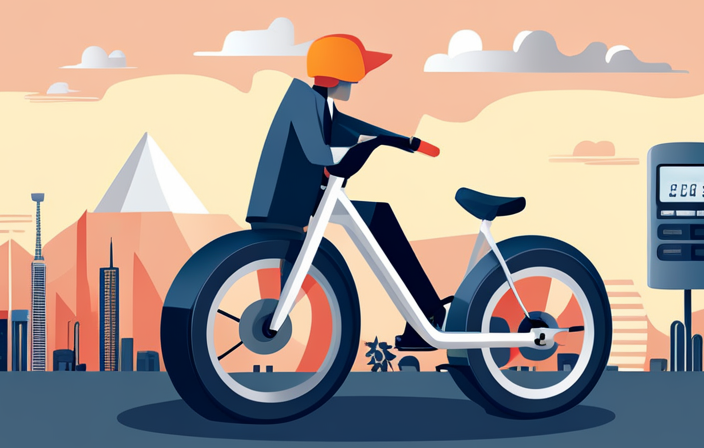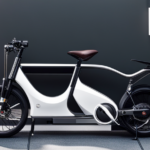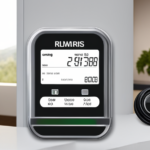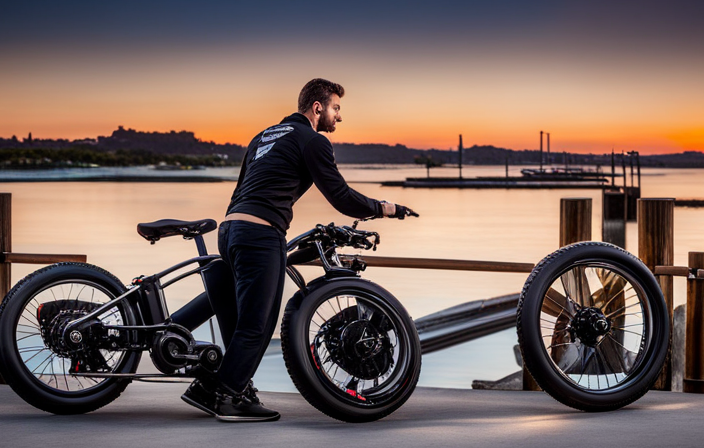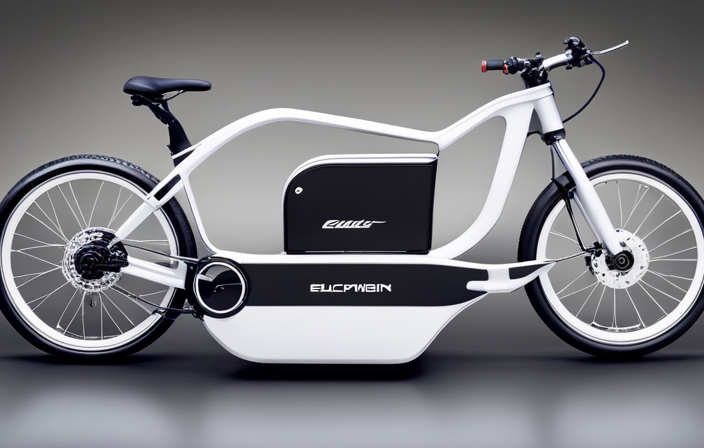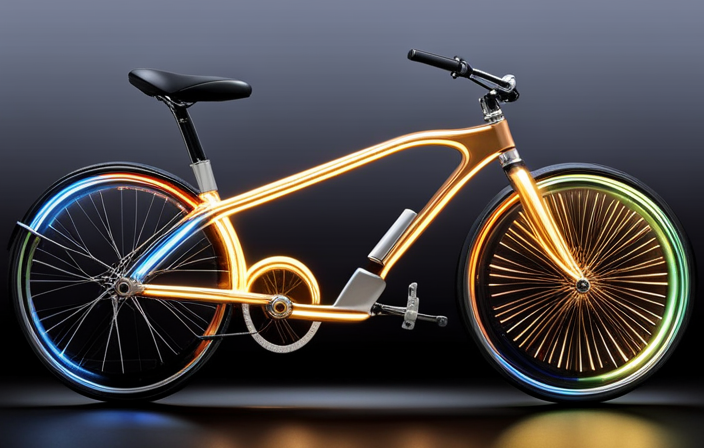Picture this: you’re gliding through the city streets, effortlessly zipping past traffic on your electric bike. It’s not just a mode of transportation; it’s a sustainable and efficient way to get around.
But have you ever wondered how much electricity it actually costs to power your electric bike? In this article, we’ll delve into the world of electric bike energy consumption, exploring the factors that affect electricity costs, estimating usage, and finding ways to manage and reduce expenses.
Get ready to dive into the numbers and discover the true cost of powering your electric ride.
Key Takeaways
- Electric bikes reduce carbon footprint and contribute to a greener future.
- Monitoring and tracking electric bike electricity expenses helps gain control over expenses and identify areas for improvement.
- Optimizing charging habits for electric bikes, such as charging during off-peak hours and utilizing solar power, reduces electricity expenses and improves sustainability.
- Future advancements in battery technology and motor efficiency will lead to longer rides, reduced charging times, and improved overall energy consumption.
Understanding Electric Bike Energy Consumption
If you’re wondering how much electricity an electric bike costs to operate, it depends on various factors such as the battery capacity and usage patterns. Estimating energy consumption is crucial when it comes to optimizing battery usage and efficiency.
The primary determinant of energy consumption is the battery capacity, which is typically measured in watt-hours (Wh). Electric bike batteries can range from 250Wh to 1,000Wh or more.
To estimate the energy consumption, you need to consider the power rating of the bike’s motor, the terrain you’ll be riding on, and the level of assist you’ll be using. On average, an electric bike consumes around 15-30Wh per mile. Other factors, such as rider weight, wind resistance, and battery capacity, also play a crucial role in determining the total energy consumption. When asking “how far can an electric bike go,” these variables must be considered to provide an accurate range estimate. Typically, a fully charged battery can last anywhere from 20 to 100 miles, depending on the efficiency of the bike and riding conditions.
For example, if you have a 500Wh battery and ride 20 miles, you can expect to consume approximately 300Wh of energy.
By understanding your bike’s energy consumption, you can optimize battery usage and enhance the overall efficiency of your electric bike.
Factors Affecting Electric Bike Electricity Costs
To determine the electricity costs of an electric bike, you should consider various factors.
One important factor is understanding energy efficiency. Different electric bike models have varying levels of energy efficiency, which can significantly affect their electricity consumption. It is essential to evaluate the energy efficiency rating of the bike you are considering to get a better idea of its power consumption and, consequently, its electricity costs.
Another factor to consider is the charging infrastructure available to you. The availability and convenience of charging stations can impact the cost of charging your electric bike. If you have easy access to charging stations at home, work, or public areas, it can greatly reduce your overall electricity costs. On the other hand, if the charging infrastructure is limited or not easily accessible, you may need to rely more on home charging, which could increase your electricity expenses.
By understanding energy efficiency and evaluating the charging infrastructure, you can get a clearer understanding of the electricity costs associated with owning and operating an electric bike.
Estimating Electricity Usage for Electric Bikes
Estimating the electricity usage for electric bikes can be done by considering various factors such as energy efficiency and charging infrastructure.
Understanding energy efficiency is crucial in determining how much electricity an electric bike will consume. Electric bikes with higher energy efficiency ratings will require less electricity to operate, resulting in lower costs. On the other hand, bikes with lower efficiency ratings will consume more electricity, leading to higher costs.
Additionally, calculating the charging time is important in estimating electricity usage. The charging time will depend on the battery capacity and the charging rate of the electric bike. Electric bikes with larger battery capacities will require more time to charge, resulting in higher electricity usage. Similarly, bikes with faster charging rates may consume more electricity during the charging process.
By considering these factors, one can get a better understanding of how much electricity an electric bike will cost to operate.
Managing and Reducing Electric Bike Energy Costs
Managing and reducing energy expenses for electric bikes can be achieved by implementing energy-saving practices and utilizing cost-effective charging strategies.
One way to reduce energy consumption is by optimizing the charging time. Charging the battery during off-peak hours, when electricity rates are lower, can significantly lower your energy costs.
Additionally, it is important to ensure that the battery is not overcharged, as this can lead to energy wastage. By monitoring the charging process and stopping it once the battery is fully charged, you can avoid unnecessary energy usage.
Another energy-saving practice is to maintain proper tire pressure, as underinflated tires can increase resistance and require more energy to propel the bike. Regularly checking tire pressure and inflating them to the recommended levels can help optimize energy efficiency and reduce costs.
Comparing Electric Bike Energy Costs to Other Modes of Transportation
Compared to other modes of transportation, electric bikes can be a more cost-effective option for commuting. Here are four key points to consider when comparing electric bike energy costs to other forms of transportation:
-
Electric bike energy costs vs. car fuel expenses: On average, electric bikes consume about 0.05 to 0.25 kWh of electricity per mile, while cars typically require around 0.3 to 0.4 gallons of fuel per mile. This significant difference in energy consumption can result in substantial savings when using electric bikes for daily commuting.
-
Environmental impact: Electric bikes have a lower environmental impact compared to cars. Electric bikes produce zero tailpipe emissions, helping to reduce air pollution and greenhouse gas emissions.
-
Maintenance costs: Electric bikes generally require less maintenance compared to cars. They have fewer moving parts and do not require regular oil changes or complex engine maintenance, resulting in lower long-term costs.
-
Additional cost savings: Electric bikes often have lower upfront costs compared to cars, and they also benefit from lower insurance and registration fees. Additionally, electric bikes can bypass traffic congestion and expensive parking fees, further reducing overall commuting costs.
When considering energy costs and environmental impact, electric bikes prove to be a compelling alternative to traditional modes of transportation.
Tips for Charging Electric Bikes Economically
To charge your electric bike economically, you can maximize energy efficiency by charging it during off-peak hours. This not only helps reduce your electricity bill, but also puts less strain on the power grid during peak demand times. Another way to save on charging costs is by using a charger with a higher efficiency rating. Investing in a charger that has a higher energy conversion rate will ensure that less energy is wasted during the charging process. Additionally, it is important to be mindful of the charging time and battery capacity of your electric bike. Charging your bike fully and avoiding overcharging can help prolong the lifespan of your battery and optimize its performance. Following these tips will help you charge your electric bike economically while ensuring its longevity.
| Charging Time | Battery Capacity |
|---|---|
| 4-6 hours | 400-500 Wh |
Exploring Renewable Energy Options for Charging Electric Bikes
Consider exploring renewable energy options for charging your electric bike, such as solar or wind power, to reduce your environmental impact and reliance on traditional energy sources.
Renewable energy sources, like solar panels, harness the power of the sun to generate electricity. By installing solar panels on your property, you can generate your own clean and sustainable energy. The amount of electricity generated by solar panels depends on various factors, including the size of the system, the location, and the amount of sunlight received.
On average, a 1 kilowatt (kW) solar panel system can generate approximately 1,200 kilowatt-hours (kWh) of electricity per year. This is enough to charge an electric bike multiple times. Additionally, excess energy produced by the solar panels can be stored in batteries for later use, ensuring a continuous supply of power even during cloudy days.
Embracing renewable energy options for charging your electric bike not only reduces your carbon footprint but also provides long-term cost savings.
Monitoring and Tracking Electric Bike Electricity Expenses
Now that we have explored renewable energy options for charging electric bikes, let’s move on to the next step: monitoring and tracking electric bike electricity expenses.
As an electric bike owner, it is essential to keep a close eye on your energy consumption and the associated costs. By tracking expenses, you can gain insights into your usage patterns and identify opportunities to reduce costs. This can be achieved by using energy monitoring devices or smart meters that provide real-time data on electricity consumption.
Additionally, you can explore ways to optimize your charging habits, such as charging during off-peak hours or utilizing solar power. By implementing these strategies, you can not only reduce your electricity expenses but also contribute to a more sustainable and cost-effective electric bike ownership experience.
- Sub-list:
- Gain control over your expenses
- Identify areas for improvement
- Contribute to a greener future
Electric Bike Energy Efficiency and Range Considerations
When thinking about the energy efficiency and range of an electric bike, it’s important to take into account factors such as battery capacity and terrain. The battery life of an electric bike refers to the amount of time the battery can power the bike before needing to be recharged. This is influenced by various factors, including the battery’s capacity and the power consumption of the bike. Additionally, the charging time of an electric bike is the amount of time it takes to fully recharge the battery. This can vary depending on the type of charger used and the battery’s capacity. By considering these factors, riders can make informed decisions about their electric bike’s energy efficiency and range, ensuring that they have enough power to reach their destination without running out of battery.
| Factors | Battery Life | Charging Time |
|---|---|---|
| Battery capacity | Determines how long the battery can power the bike before needing to be recharged | – |
| Power consumption | Influences the battery life and range of the electric bike | – |
| Charger type | – | Determines the time it takes to fully recharge the battery |
| Battery capacity | – | Influences the charging time |
Future Developments in Electric Bike Energy Consumption
To improve the energy consumption of your electric bike in the future, you can explore advancements in battery technology and motor efficiency.
With future advancements, electric bikes are expected to become even more energy efficient, allowing for longer rides and reduced charging times.
Battery technology is constantly evolving, with researchers working on developing batteries that have higher energy densities and longer lifespans. These improvements will enable electric bikes to travel farther on a single charge and have a longer overall lifespan.
Additionally, motor efficiency is another area of focus for future developments. By making motors more efficient, electric bikes will require less energy to operate, resulting in extended battery life and reduced electricity costs.
Overall, future advancements in battery technology and motor efficiency will play a crucial role in improving the energy consumption of electric bikes.
Frequently Asked Questions
Are there any government incentives or subsidies available for electric bike owners to offset electricity costs?
Yes, there are government incentives and subsidies available for electric bike owners to offset electricity costs. These programs vary by country and region, but they aim to promote sustainable transportation and reduce reliance on fossil fuels.
Can I charge my electric bike using solar power or other renewable energy sources?
Yes, electric bikes can be charged at home using solar power or other renewable energy sources. This not only reduces reliance on the grid but also provides environmental benefits by using clean energy to power the bike.
How long does it typically take to fully charge an electric bike battery?
Charging an electric bike battery is lightning fast! With an average charging time of just a few hours, you can quickly replenish the battery’s capacity and get back on the road in no time.
Are there any specific maintenance tips or tricks to improve the energy efficiency of an electric bike?
To improve the energy efficiency of an electric bike, follow these maintenance tips: keep tires properly inflated, lubricate the chain regularly, clean the bike after each ride, and ensure the battery is charged to optimal levels.
What are some common misconceptions about electric bike energy consumption and costs?
Common misconceptions about electric bike energy consumption and costs include overestimating the true energy consumption and assuming high costs. However, with efficient battery technology and advancements in electric motors, electric bikes are more affordable and energy-efficient than commonly believed.
Conclusion
In conclusion, understanding the electricity consumption of electric bikes is crucial for managing costs and optimizing efficiency. Factors such as speed, terrain, and battery capacity significantly impact energy usage. By estimating and tracking electricity expenses, riders can better manage their budget.
Additionally, comparing electric bike energy costs to other forms of transportation highlights the cost-effectiveness and environmental benefits. As renewable energy options continue to expand, charging electric bikes with clean energy sources becomes a viable choice.
With advancements in energy consumption and range, the future of electric bikes looks promising.
How will you harness the power of electric bikes to revolutionize your commute?
